Is It Bad To Store Your Bike Outside?
Leaving your bike outside for a few days isn’t going to be a big deal, even if it ends up raining. However, you’re going to start seeing visible damage after a week of it being outside.
Saying that, there are several ways you can minimize or even remove this risk altogether. Want to know how?
Yeah, you guessed it…keeping reading 😁
What Happens When You Leave Your Bike Outside?
Depending on how you store your bike outside, components can start showing rust – how quickly that happens will depend on a few factors.
As we know, bikes are different. They are made differently, using different materials and the weather does affect bikes differently.
- Chain
Stainless steel chains are less likely to deteriorate than other chains. Typically you find stainless steel chains on the more higher-end bikes but there isn’t anything stopping you from upgrading your chain. In fact, it may increase your performance so there’s almost no reason why you wouldn’t! 😉
- Bolts
The bolts on your bike can seize up quickly as they start to corrode and this can bring about lots of problems. With bolts, I would highly recommend that you grease them, this just adds an extra layer to prevent water, dirt, and debris from getting to them.
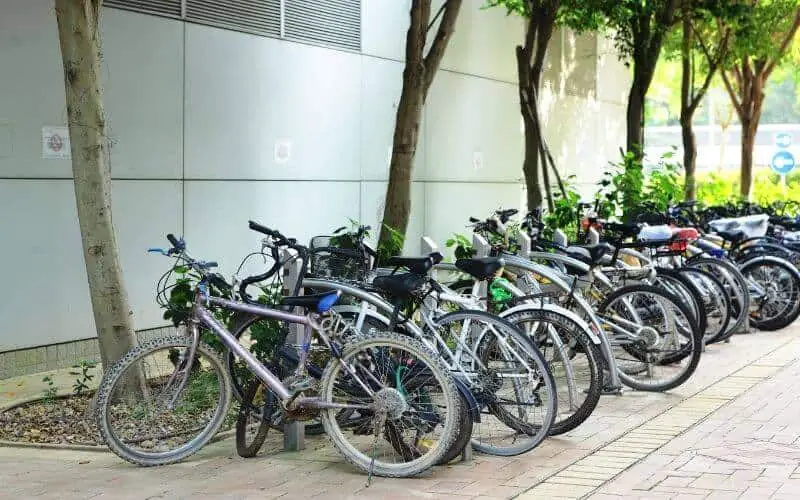
- Seals
As your bike ages, the seals become less effective. The purpose of a seal is to prevent water and moisture from getting into areas it shouldn’t – wheel hubs, bearings, cranks, cogs, etc. If you’re leaving your bike exposed to the elements then this is not only going to speed up the degradation of the seals but more moisture is going to get in.
- Rubbers and Plastic
Plastic and rubber features in a fair few places on bikes. As time passes, these two can start to break down – this is sped up by exposure to the sun and humidity. You guessed it, leaving your bike exposed all the time means that the erodion will happen more quickly.
The parts most likely to suffer are the tires, inner tubes, rum strip, cable housing, saddle, and brake hoods. So all fairly important components!
- Steel frame
Steel frames are known for being robust. However, even steel can’t beat Mother Nature.
If you scratch or dent your paintwork, I’d recommend sealing it as soon as you spot it as when moisture gets in there it can cause the frame to rust.
Related article – How Long Do Steel Bike Frames Last?
- Aluminum frame
Aluminum frames aren’t as likely to rust. It can eventually happen but it’s less of a problem than steel frames simply because of the material.
If you have an aluminum-framed bike, I would suggest you focus on protecting the steel parts, these are usually the cables, gears, chain, and bolts.
As you can see, there are plenty of components that do get damaged by being outside and the longer your bike is outside, the more quickly this will happen.
Related article – Best Bicycle Covers For Storage
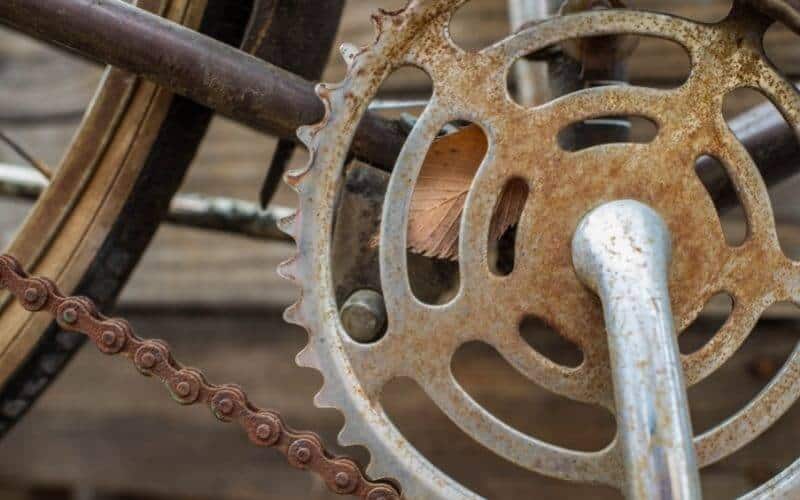
How Long Does It Take For Parts To Degrade?
The time taken for damage to occur will vary according to where your bike is. Is it in direct sunlight or getting wet a lot?
Let’s take a worst-case scenario – it’s probably around a month for corrosion to do some serious damage.
If you live somewhere with pretty perfect weather and your components are mid-range or better then you could be looking at three to four months before you can visibly see any damage on your bike.
How Do I Keep My Bike From Rusting Outside?
There are a few easy steps you can take.
I would highly recommend a bit of tarp to put over your bike when it’s outside. It goes a long way to shield it from the sun and rain.
What you should try to do is suspend the tarp above your bike slightly. If you lay the tarp directly onto the bike then it creates an almost tent effect – meaning that it traps moisture in there – rust breeding ground!
I’d also suggest that you apply a little extra layer of grease over the seals. This extra layer gives a second barrier that can help prevent water from getting in.
Bolts seizing up is another concern but also preventable! Lube up your cables and bolt heads – I’d even go as far as doing the threads of the bolts, you know where they interface with other parts? This will help to prevent bolts seizing and rusting, which I can assure you, you don’t want!
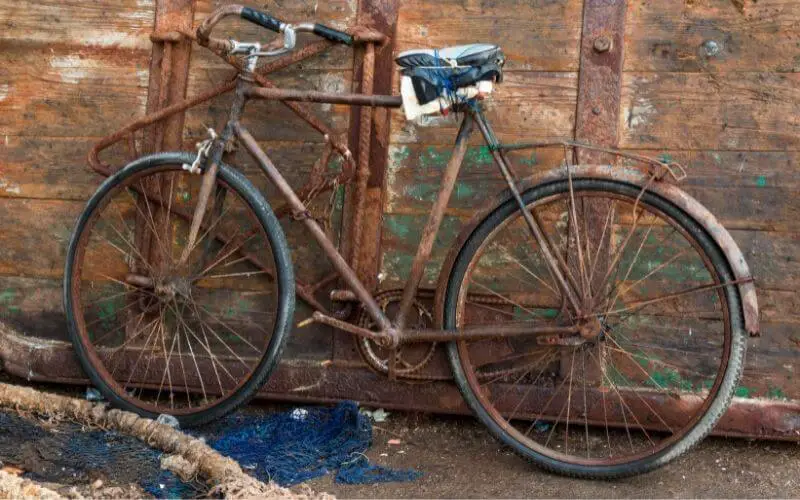
Top 3 Tips For Protecting Your Bike From The Weather
Here are my top 3 tips on how to protect your bike.
Storage. Security. Insurance.
Basically, the 3 key things you need to consider when you’re planning on keeping your bike outdoors!
Outdoor Storage Ideas
Bicycle Sheds
If you have a yard or garden then without a doubt, a bike shed is your best option for storing your bike (or several!).
You can buy bike sheds in different materials (metal, plastic, or wood).
Something like the Rubbermaid shed can provide you with enough space to securely store your bike and plenty of accessories, without having to worry about the weather!
The obvious upside of a shed is that you can put a lock on it to secure it.
However, the downside is that sheds can be pricey. Though they can be a great investment that will last for many years.
Bike Tent
No space for a shed? A bike tent could be your answer!
Bike tents come in a host of shapes and sizes. You can get ones made in high-quality materials, ones with lots of features.
If you get yourself a heavy-duty one like YardStash, your bike will be nicely protected against wind, rain, sun, and snow.
The advantage of a bike tent is that they are affordable and give you plenty of flexibility around where/how you store your bicycle.
Disadvantage-wise, a tent is never going to be totally secure.
Bike Cover
A bike cover can give you that long-term storage solution. They are designed to be durable, waterproof, and stretchable.
Good (but affordable) bike covers come with straps so they can be secured to your bike. Bike covers are great because they protect your bike against moisture, the sun, and dust.
However, they, of course, do quite clearly indicate what is underneath so, from a security perspective, they don’t get full marks!
Bike covers are portable though and usually can be folded into something very small so if you want to park your bike up for a short while, but keep it protected, they are great for that.
Tarp
Some cyclists do use a tarp as a shelter for their bikes.
It’s not the best option out there as you do have to be careful how you do it. Wrapping it too tightly around your bike can result in a pocket of moisture which will damage your bike.
The good thing about the tarp is that it’s cheap. You can buy it from your local hardware store and they’re durable.
Waterproof Seat Cover
When exposed to the elements, your saddle can crack. Saddles aren’t cheap to replace – certainly not if you want a decent one so it’s best avoided.
You can pick up a dedicated seat cover, these will protect your saddle from wind, rain, the sun, and dirt.
The cover is commonly kept in place by a drawstring so it’s held in place, even on windy days.
Seat covers aren’t expensive but they do protect an important part of your bike. The downside to a seat cover is that it is only there to protect your saddle, the rest of your bike still remains exposed.
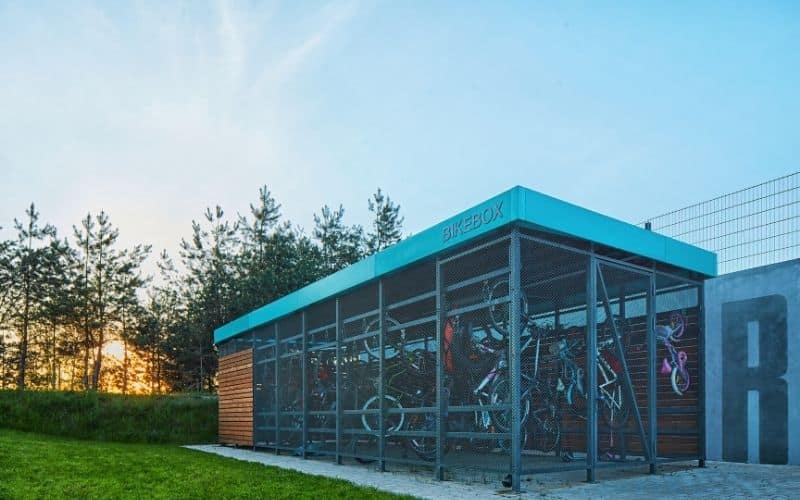
Other Helpful Tips
Security
Wherever you’re storing your bike, you need to think about how you’re going to secure it, or at least deter thieves.
If you have a bike shed, you have a few options.
Rip up a section of the floor in the shed. Dig a hole into the earth and fill it with concrete. You can then put in an anchor, such as the Oxford Terra Force to set it into the wet concrete.
I’m not going to lie, that can be a lot of work and isn’t feasible if your shed is made from plastic but for some, it could be a viable and worthwhile option.
If you can hang your bike from the roof of the shed, or the wall, I would recommend doing that. It makes it more difficult for the thief to get at your bike. That’s the aim, make it too difficult for the thief to even try and steal your bike.
Shed alarms can be purchased fairly inexpensively and work by sounding an alarm when the door or windows are opened.
You most certainly want to have a chain on your bike and ideally, that chain should be attached to something else.
If you don’t have a bike shed, then you could consider the concrete planter option. This is where you take a container (a planter works well – hence the name!), fill it with concrete and an anchor, much like the Oxford Terra Force, mentioned above. This gives you a secure place to chain your bike to.
I would go a step further and cover your bike, be that with a dedicated bike cover or some tarp. The planter should keep you safe from thieves, the cover should keep the bike protected from weather and prying eyes.
Want to see how easy it is to steal a bike?
Insurance
Many insurance companies will want you to use an approved security lock when securing your bike. Depending on the value of your bike, will depend on the level of security rating your lock will need to be.
I purchased the highest-rated security lock for my bikes and I am nothing but impressed by them. The peace of mind alone is worth the money.
You will also need to ensure that you secure your bike to an immovable object (using the approved security lock).
What is an “immovable object”?
It needs to be an object that cannot be undone or removed unless using extreme force. By that I mean, needing to use power tools or other machinery to move it.
It also needs to be an object whereby the bike cannot be lifted, either over or under, without having broken the approved lock.
Some insurers will allow you to store your bike in your shed providing that the shed has particular locks on it.
It really does vary from company to company but my advice is to be honest with them so you can be certain that you will be covered should you ever need it.
Frequently Asked Questions
Can You Leave An Electric Bike Outside?
You should really be looking at storing your electric bike indoors. There are many components that will suffer from damp and moisture damage no matter how well protected they are outside.
However, if that isn’t possible, you can store your e-bike outside but there are a few steps you will want to do to preserve your electric bike.
The battery. Remove it and store it somewhere where the temperature is controlled and doesn’t fluctuate between high and cold temperatures. Ideally, indoors.
Secondly, keep it protected from the sun and rain. Both can damage the electrical components in their own ways.
Thirdly, electric bikes are more likely to be stolen so take some security measures to minimize the risks.
How Do I Store My Bike On My Porch?
If you want to store your bike on your porch, I would recommend getting a bike cover as this will help to keep your bike safe from the weather.
If there is a way to secure your bike, then do so. I suggest using the concrete planter method (explained above) as a way to do secure your bike and keep your porch, looking like a porch!
Final Thoughts
Lack of indoor storage space shouldn’t stop you from having a bike!
As you can see, there are plenty of options so it’s just a case of finding the right one for you.
Insurance is always advisable but don’t forget the security aspect of it.
What’s your storage hack?

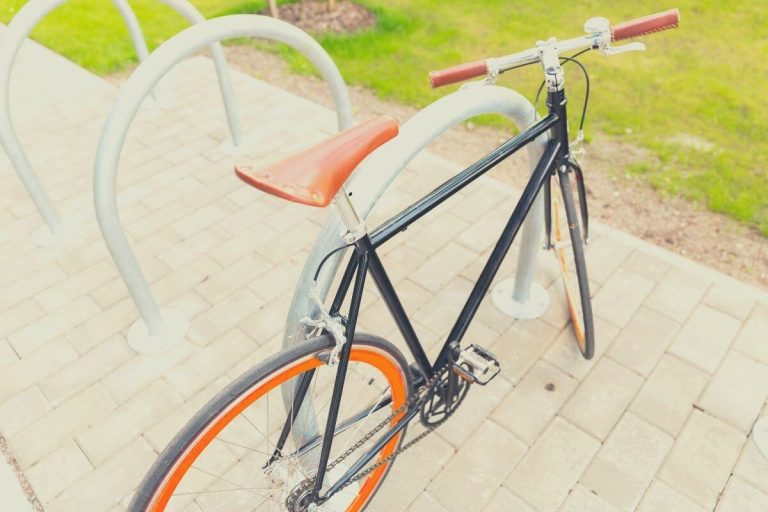
thank you for making this article very useful and keep up the good work